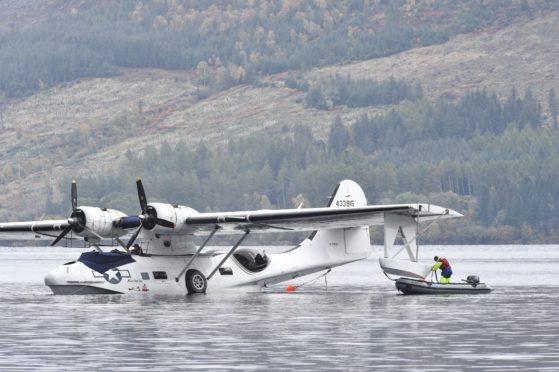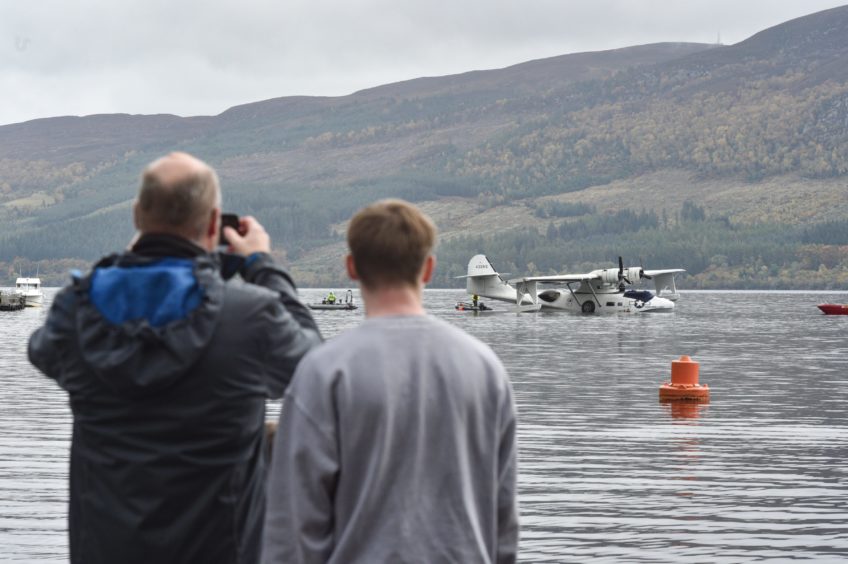A 10 tonne Second World War flying boat was gently lifted from Loch Ness earlier today to start the repairs needed to save the historic aircraft.
The Miss Pick Up, one of the world’s only airworthy Catalina flying boats, suffered engine trouble at the weekend while trying to take off on the loch after completing a filming project.
It was towed to safety by the Loch Ness RNLI lifeboat crew and had been moored to a buoy in Urquhart Bay as operators Plane Sailing in Duxford, Cambridge, planned a rescue operation.
What was originally thought to be a faulty starter motor turned out to be a more serious problem which prevented the starter motor from turning over.
It was decided engineers would have to undertake a complete right engine change and send the damaged engine off for overhaul.
Today a carefully planned logistical operation began to move the aircraft.
It was towed across Urquhart Bay to Temple Pier and then hoisted off the water by a crane provided by local firm Stoddart Crane Hire.
Ahead of the task, spare items including tools, servicing supplies, and even a small toilet, were removed from the plane to reduce her weight to a minimum.
The operators were desperate to avoid leaving the plane too long as prolonged time on the water would do irreparable damage.
Ian Brookes, a director of Catalina Aircraft, said the lifting operation went according to plan.
“Clearly we were all worried about it as no one has lifted a Catalina on a crane for 20-30 years,” he said.
“There are lift points built into the Catalina, on the side of the wing, but we were worried about the structure of the aircraft. It went well, though, so it’s good news.
“It was a risk on the water as the longer you leave it and the worse the weather gets the more damage you are going to get, so we were really pleased to get it out.”
The plane operator will now send up a replacement engine and repairs will be carried out on dry land.
After that, the Catalina will be put back in the water and, after some testing, will be flown to Inverness Airport.
Following some more checks it’s hoped it will return to its home base in a few weeks.
Mr Brookes added: “Everyone in the area have been a great help and we are grateful to them for their kind hospitality.
“It’s been a worrying experience but it’s also been uplifting because of the amount of help and goodwill that has been forthcoming from the community.”
An online appeal was also set up on GoFundMe to raise £20,000 to pay for the operation to recover the aircraft, which is operated by volunteers.
So far it has brought in £15,636 from generous donors.
David Legg, a volunteer who was crew chief on the Catalina when it arrived at Loch Ness, said the operators are “excited, grateful and humbled” by the financial support received.
“It’s extraordinary and just shows what a love there is for this type of aeroplane.
“I don’t think we expected the positive result we have received, but it’s a lovely aeroplane and captures peoples’ imagination.
“There are not that many flying in the world. There are about 14 and we are the only one flying with any regularity in Europe.”
He added: “In 35 years of operating Catalinas it’s the biggest challenge our organisation has faced without a doubt.
“This is one operation we would rather not be doing but we are where we are. Old aeroplanes sometimes have problems and we have to face them.”











